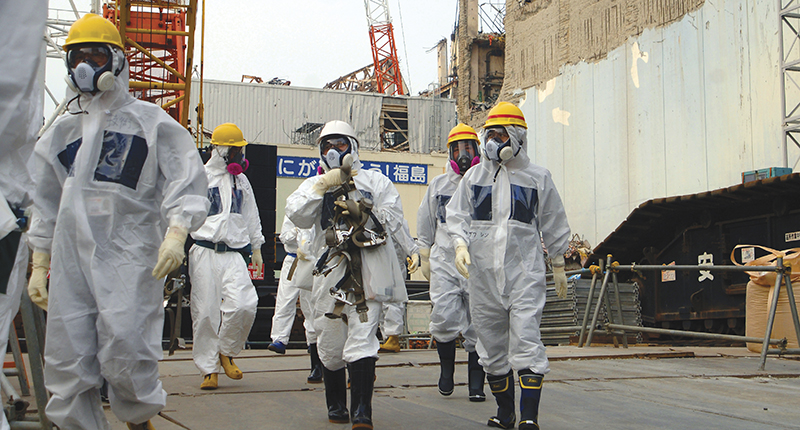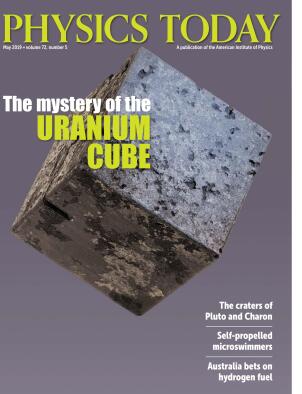The past and future of nuclear regulation
DOI: 10.1063/PT.3.4207
Gregory Jaczko is a physicist who ventured into the political arena after he earned his PhD. In his subsequent career as a nuclear regulator, he had a rapid rise—and an equally sudden fall. In Confessions of a Rogue Nuclear Regulator, he tells his story and gives valuable insights into the inner workings of US nuclear regulation.

Inspectors at the Fukushima Daiichi power plant in 2013.
GREG WEBB/IAEA

In 1999 Jaczko started as a congressional science fellow in the office of Representative Edward Markey (D-MA), a critic of the safety oversight of the US Nuclear Regulatory Commission (NRC). Jaczko then joined the staff of Democratic senator Harry Reid, who was focused on stopping the licensing of the Yucca Mountain radioactive waste repository that the US Department of Energy was building in his home state of Nevada.
In 2005 Reid succeeded in getting Jaczko a seat on the five-member Nuclear Regulatory Commission. Four years later President Barack Obama appointed Jaczko NRC chairman. While campaigning in the Nevada primary, Obama had pledged that, if elected, he would end the licensing process for the Yucca Mountain repository. The site had been selected by Congress in 1987, when Reid was a junior senator with little clout. After Obama’s election, the two worked together to scuttle the repository and succeeded in 2011.

Jaczko’s book is in large part a rebuttal to industry critics who attacked his decisions on a number of issues, including his recommendation that US citizens in Japan evacuate any area within an 80-kilometer radius of the Fukushima Daiichi plant—far beyond the 20- to 50-kilometer distance ordered by Japan’s government. He also defends himself against accusations from his fellow commissioners that he was on occasion abusive toward NRC staffers, berating them when he thought they were giving in to pressure from proindustry commissioners.
As a longtime observer of the US nuclear regulatory process, however, I was disappointed that Jaczko does not discuss the outcomes of the NRC’s important decisions on post-Fukushima safety upgrades. Presumably that is because by the time the commission held its final votes on those upgrades in 2015, Jaczko had been forced out by his former boss Reid. Republicans planned to reappoint a proindustry and pro–Yucca Mountain NRC commissioner, Kristine Svinicki, to another five-year term. As Jaczko reports matter-of-factly, Reid, by then the Senate minority leader, wanted Jaczko out so he could appoint a Yucca Mountain critic to serve a full five-year term matching Svinicki’s. Reid chose geologist Allison Macfarlane as NRC chair. Macfarlane stepped down after two and a half years, however, and in 2017 President Trump appointed Svinicki as chair.
The decisions on post-Fukushima upgrades put into stark relief the politics of nuclear regulation in the US at a time when nuclear power is failing to compete with cheap natural gas, wind, and photovoltaic energy. Because of its poor finances, the US nuclear power industry refuses to make any costly safety investments. According to the NRC, US nuclear utilities will spend an average of $40 million per reactor on post-Fukushima upgrades. In contrast, the estimated average per-reactor cost of upgrades required by regulators in France and Japan will be about $210 million and $640 million, respectively.
One investment the US industry deemed too costly was a heavy-duty filtration system to remove radioactivity from gases vented from an overpressurized reactor containment structure. European regulators began to require such filters after the 1979 accident at the US Three Mile Island plant, but US and Japanese regulators did not. The unfiltered gases released from three overpressurized Fukushima reactor containments resulted in land contamination that required the long-term relocation of about 100 000 people.
Since Fukushima, Japan’s utilities are being required to install filters in all of their reactor containments. The NRC staff estimated that filtered vents would cost US nuclear utilities between $15 million and $20 million per reactor and recommended that they be installed in US reactors with the same small-volume containments as the Fukushima reactors. But US nuclear utilities opposed the idea of filters, and the NRC ultimately voted against requiring them.
As Jaczko explains, the NRC justifies rejecting safety upgrades through a probabilistic cost–benefit analysis, in which the cost of an upgrade is weighed against the increased losses from hypothetical reactor accidents in its absence, multiplied by the estimated probability of accidents occurring during the remainder of the reactor’s currently licensed life. According to the memoir A Brighter Tomorrow: Fulfilling the Promise of Nuclear Energy (2004) by former senator Pete Domenici (R-NM), the NRC adopted that approach after Domenici, then chairman of the Senate appropriations subcommittee with oversight of the NRC’s budget, threatened to cut the NRC’s funding by one-third if he continued to hear complaints from the nuclear industry.
Between 2012 and 2016, I was a member of a National Academy of Sciences committee that studied the lessons the US could take away from the Fukushima accident. During that time, I examined two major NRC cost–benefit analyses and learned that such analyses are skewed by arbitrary probability assumptions—assuming a zero probability of a successful terrorist attack, for example—and by underestimates of accident consequences. In its analysis of the filtered-vent decision, for instance, the NRC staff estimated that the average off-site damage from a Fukushima-scale release of radioactivity in the US would be $2 billion. As of December 2016, Japan’s official estimate of the off-site costs for decontamination and compensation for the Fukushima accident was ¥13.5 trillion, or about $125 billion.
Jaczko’s book provides insights into the politics behind such skewed analyses and suggests that a reform-minded Congress might usefully look into the NRC’s regulatory process.
More about the Authors
Frank N. von Hippel, a nuclear physicist by training, is a senior research physicist and professor emeritus of public and international affairs in Princeton University’s Program on Science and Global Security, which he cofounded. From 1993 to 1994 he served as assistant director for national security in the White House Office of Science and Technology Policy. In 2010 he received the American Physical Society’s Leo Szilard Lectureship Award for his public policy work.
Frank N. von Hippel. Princeton University, Princeton, New Jersey.




